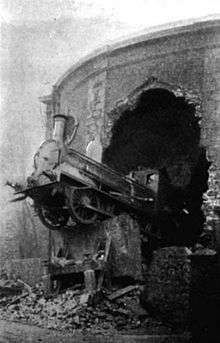Dublin and South Eastern Railway
| Dates of operation | 1846–1925 |
|---|---|
| Predecessor |
Dublin and Kingstown Railway Dalkey Atmospheric Railway |
| Successor | Great Southern Railways |
| Track gauge | 1,600 mm (5 ft 3 in) |
| Length | 161 miles (259 km) |
The Dublin and South Eastern Railway (DSE) was an Irish gauge (1,600 mm (5 ft 3 in)) railway in Ireland from 1846 to 1925. It carried 4,626,226 passengers in 1911.[1] It operated a main line from Dublin to Wexford, with branch lines to Shillelagh and Waterford.
It was incorporated by Act of Parliament in 1846 as the "Waterford, Wexford, Wicklow and Dublin Railway Company". In 1860 it was renamed the "Dublin, Wicklow and Wexford Railway Company" and on 31 December 1906 it was renamed again as the DSE. Amongst the lines forming the DSE was the Dublin and Kingstown Railway, which was authorised in 1831 and opened in 1834 – the first public railway in Ireland. The Kingstown – Dalkey section was operated by atmospheric traction for a short while. The railway formed part of the Royal Mail route between London and Dublin via Dún Laoghaire railway station at Kingstown (now Dún Laoghaire).
The DSE had two main stations in Dublin on separate lines; Westland Row (renamed after Patrick Pearse in 1966) and a terminus at Harcourt Street. It also owned the Marine Station Hotel at Bray and the Grand Central Hotel at Rathdrum, south of Wicklow.
History
Dublin and Kingstown Railway
The Dublin and Kingstown Railway (D&KR) was Ireland’s first railway. It linked Westland Row in Dublin with Kingstown Harbour in County Dublin. It was authorised in 1831, and the first part of the line running from Dublin to Kingstown Pier was opened on 17 December 1834, with an extension to Kingstown ( Dún Laoghaire station’s current location) opened on 13 May 1837.
The Dalkey Atmospheric Railway was an extension of the Dublin and Kingstown Railway to Atmospheric Road in Dalkey in County Dublin. It was unofficially opened as far as Sandycove on 19 August 1843. The route from Sandycove to Dalkley (atmospheric station) was opened on 19 March 1844, in time for the official opening of the on 29 March 1844. It used part of the Dalkey Quarry industrial tramway, which was earlier used for the construction of Kingstown (Dún Laoghaire) Harbour. It was the first railway of its type in the world.
Dublin, Wicklow and Wexford Railway Company
The DSE was incorporated by Act of Parliament in 1846 as the "Waterford, Wexford, Wicklow and Dublin Railway Company". In 1860 it was renamed the "Dublin, Wicklow and Wexford Railway Company". They leased the Dublin and Kingstown railway in 1854, converted it from 4 ft 8 1⁄2 in (1,435 mm) gauge to their 5 ft 3 in (1,600 mm) gauge. The remainder of the line to Wexford was opened over the next 20 years in stages.
The first section of DW&W line from Dalkey to Bray was opened on 10 July 1854. A continuous route from Dublin to Wicklow was established the following year, when the section from the Dublin and Kingston terminus at Dalkey (atmospheric station) to DW&W's Dalkey station was opened on 10 October 1855, and the extension from Bray to Wicklow (Murrough) opened 3 weeks later on 30 October. Coastal erosion has been a problem on the route to Wicklow, forcing the opening of a deviation between Ballybrack and Bray on 1 October 1915, and numerous deviations between Bray and Wicklow.
The line was extended onward to Enniscorthy in the early 1860s, starting with the line from Wicklow Junction to Rathdrum (Kilcommon), which opened on 20 August 1861. At this time the line from Wicklow Junction to the Murrough station was bypassed. It remained in use as a freight station and saw occasional passenger services. This was followed by further extensions to Ovoca (Avoca) on 18 July 1863 and Enniscorthy on 16 November 1863.
In the early 1870s the route was finally completed to Wexford in the 1870s, with the route from Enniscorthy to Wexford (Carcur) opening on 17 August 1872, and extended to Wexford North in August 1874.
Branch To Waterford
A branch was opened to New Ross in 1887. This left the main line at Macmine near Wexford. It was extended from New Ross to Waterford in 1904. This extension connected with the Great Southern and Western Railway, which in turn connected with trains for the south of Ireland.
City of Dublin Junction Railway
The City of Dublin Junction railway opened on 1 May 1891. This connected the DW&W and Westland Row station with Dublin Connolly railway station in the north of the city.
Accidents and incidents
- On 9 August 1867, the Brandy Hole Viaduct collapsed under a train at Bray, County Wicklow due to sudden subsidence. A passenger train was derailed and most of the coaches fell into the ravine below. Two passengers were killed, and there were a further 25 injuries.[2]
 Bray Head in 1867
Bray Head in 1867 - On 20 February 1900, a cattle train overran buffers at Harcourt Street station, Dublin.[3]
 Harcourt Street
Harcourt Street
Rolling Stock
According to the Railway Year Book 1912,[1] the railway operated 60 locomotives, hauling 253 passenger coaches and 1,005 goods vehicles. The locomotives were painted black picked out with red bands and gold lines, while the passenger vehicles were crimson lake with gold lines.
One DSE steam locomotive is preserved: a 2-6-0 goods locomotive No. 15 (later Great Southern Railways No. 461) owned by the Railway Preservation Society of Ireland at Whitehead, County Antrim.
See also
References
- 1 2 Railway Yearbook 1912. London: Railway Publishing Co. 1912.
- ↑ "Board of Trade, Bray Head, 1867" (PDF). Railways Archive.
- ↑ Trevena, Arthur (1980). Trains in Trouble: Vol. 1. Redruth: Atlantic Books. p. 15. ISBN 0-906899-01-X.
Further reading
- Shepherd, W. Ernest; Beesley, Gerry (2003) [1998]. The Dublin and South Eastern Railway: An Illustrated History. Leicester, Shepperton: Midland Publishing. ISBN 1-85780-082-6.
